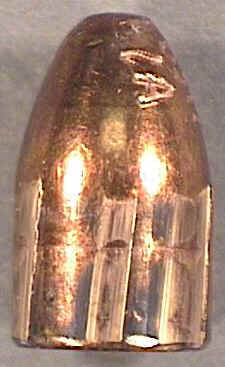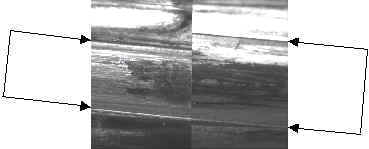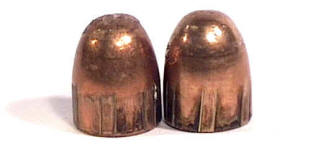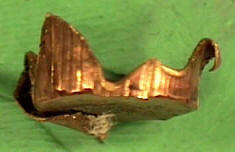Rifling Impressions
A
bullet is slightly larger in diameter than the bore diameter
of the barrel in which it is designed to be fired. The bore
diameter is the distance from one land to the opposite land in a
barrel. As a result, a rifled barrel will
impress a negative impression of itself on the sides of the bullet
like those seen below.

The rifling
pattern in the barrel that fired a particular bullet can be determined
by counting the number of groove
or land impressions around the circumference of the bullet. Then, by holding the
nose of the bullet pointing away from you, the direction the
impressions run away from you (either to your left or right)
determines the direction of twist. If the rifling
impression pattern on the bullet matches the rifling pattern in the
barrel of the questioned firearm, the next step is to measure the
rifling impressions on the bullet.
The lands and grooves
on a bullet are measured in thousandths of an inch or in
millimeters. One
way to measure individual rifling impressions is to use a micrometer
like the one below. The right image below shows the micrometer
positioned next to a land impression on a bullet.
This is
important because even though the rifling pattern may match between
the bullet and questioned barrel one 6/right rifled barrel can have lands and grooves
of a differing width than another. The
image below shows the land impressions on two bullets. Both were
fired from 6/right rifled barrels. The land impressions are
lined up at the bottom edge but as you can see, the upper edges do not
line up because the land impression on the right bullet is wider.

The widths of the lands
and grooves on a bullet provide a further class characteristic that can
be used as a preliminary means to determine if the submitted bullet
could have been fired from the submitted firearm.
Another
class characteristic of rifling that is seldom comes into play is the rate
of twist or pitch of the rifling in the barrel. The
rate of twist is the distance the rifling needs to spiral down the
barrel for it to complete a single revolution. An example would
1 turn in 12 inches. The term pitch refers to the angle at which
the rifling is cut in the barrel. The two images below show the
rifling in a 5 inch barrel on the left opposed to a 1 3/4 inch barrel
on the right. Note the difference in pitch of the rifling.
The barrel on the right actually has very little pitch to the
rifling. Depending on which way you look at it the direction of
twist could be to the right or left. It is a 10/right rifled
barrel.
When
bullets are compared to standards from a given barrel the pitch to the
rifling impressions can be a means to eliminate the bullet as having
been fired from the firearm. If the angle disagrees with the angle
found on standards then the comparison will be a negative one based on
those class characteristics. The problem with this is that it is
hard to accurately measure the pitch. Unless there is a noticeable
difference in the pitch, it can be hard to use this class characteristic
as a means of elimination. As a result, firearm examiners rarely
measure the rifling impression pitch. The two bullets below were
fired from different 6/right rifled barrels but the pitch is
different. Not by much though and any damage to a bullet like this
could make the difference difficult if not impossible to see.

Firearm examiners can run into problems determining any of the previously
described class rifling
characteristics on the bullet if the bullet is damaged like the one seen
below.

You may get a bullet fragment that
only has one or two land and groove impressions and the
direction of twist may not be obvious.
Therefore, here is where a little math comes in. Let us say you have a fragment with only
one land and one groove impression visible (the minimum number for
this to work). You measure the land
impression width to be .055 inches and the groove impression width to
be .130 inches. Divide the diameter of the bullets suspected or
measured caliber, in this case .357, by the sum of the width of the
one land and groove impression (.185), and then multiply that number
by pi (3.14).
.357 / .185 * 3.14 = 6.05
This
will give you the approximate number of lands or grooves that would have
been in the barrel that fired the bullet. In this example, the
approximate number of lands and grooves would be six.
If a
bullet is badly damaged and exhibits poor class characteristics not all is
lost. There is still a possibility that some unique
microscopic marks from the barrel still exist on
the surface of the bullet.
Click
the Next button below to continue.
|